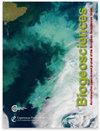蓝藻在氧碱性条件下对富铁、富锰和富硅矿物相的生物矿化作用
IF 3.9
2区 地球科学
Q1 ECOLOGY
引用次数: 0
摘要
摘要铁和锰在氧和碱性溶液中是难溶的元素,而在缺氧条件下则更容易溶解。因此,富铁和/或锰的自生矿物相的形成传统上被视为全球或局部缺氧条件的诊断。在这里,我们发现一些特定的蓝藻非常小的尺寸(<在墨西哥的碱性湖泊中,2µm,即picocyanobacteria)可以在氧条件下将丰富的、自生的Fe(III)-, Mn(IV)-和si富非晶态相生物矿化。由此产生的生物矿物聚集成小球体,排列成环围绕蓝藻细胞的分裂隔膜。这些环被包裹在一个有机的,可能是多糖的包膜中,在沉积过程中至少在形态上被部分保存下来。根据它们的16S rDNA序列,这些蓝藻属于聚球菌目。生物矿物的高铁和高锰富集对基于它们的检测的缺氧条件的系统推断提出了质疑。此外,这个过程从水柱中清除铁,这是一个被忽视的铁循环的生物贡献。最后,揭示了细菌控制富硅相生物矿化的新案例。本文章由计算机程序翻译,如有差异,请以英文原文为准。
Biomineralization of amorphous Fe-, Mn- and Si-rich mineral phases by cyanobacteria under oxic and alkaline conditions
Abstract. Iron and manganese are poorly soluble elements in oxic and alkaline solutions, whereas they are much more soluble under anoxic conditions. As a result, the formation of authigenic mineral phases rich in Fe and/or Mn has traditionally been viewed as diagnostic of global or local anoxic conditions. Here we reveal that some specific cyanobacteria of very small size (< 2 µm, i.e., picocyanobacteria) can biomineralize abundant, authigenic Fe(III)-, Mn(IV)- and Si-rich amorphous phases under oxic conditions in an alkaline lake in Mexico. The resulting biominerals cluster as small globules arranged as rings around the division septum of cyanobacterial cells. These rings are enveloped within an organic, likely polysaccharidic envelope and are partially preserved, at least morphologically, upon sedimentation. Based on their 16S rDNA sequence, these cyanobacteria were affiliated with the Synechococcales order. The high Fe and Mn enrichment of the biominerals questions the systematic inference of anoxic conditions based on their detection. Moreover, this process scavenges iron from the water column, an overlooked biological contribution to the Fe cycle. Finally, it reveals a new case of controlled biomineralization of Si-rich phases by bacteria.
求助全文
通过发布文献求助,成功后即可免费获取论文全文。
去求助
来源期刊

Biogeosciences
环境科学-地球科学综合
CiteScore
8.60
自引率
8.20%
发文量
258
审稿时长
4.2 months
期刊介绍:
Biogeosciences (BG) is an international scientific journal dedicated to the publication and discussion of research articles, short communications and review papers on all aspects of the interactions between the biological, chemical and physical processes in terrestrial or extraterrestrial life with the geosphere, hydrosphere and atmosphere. The objective of the journal is to cut across the boundaries of established sciences and achieve an interdisciplinary view of these interactions. Experimental, conceptual and modelling approaches are welcome.
 求助内容:
求助内容: 应助结果提醒方式:
应助结果提醒方式:


